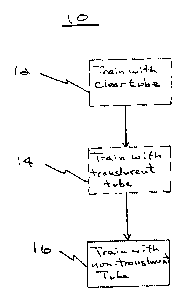Some of the information on this Web page has been provided by external sources. The Government of Canada is not responsible for the accuracy, reliability or currency of the information supplied by external sources. Users wishing to rely upon this information should consult directly with the source of the information. Content provided by external sources is not subject to official languages, privacy and accessibility requirements.
Any discrepancies in the text and image of the Claims and Abstract are due to differing posting times. Text of the Claims and Abstract are posted:
| (12) Patent: | (11) CA 2556179 |
|---|---|
| (54) English Title: | ANIMAL TRAINING METHOD |
| (54) French Title: | METHODE DE DRESSAGE D'ANIMAL |
| Status: | Granted and Issued |
| (51) International Patent Classification (IPC): |
|
|---|---|
| (72) Inventors : |
|
| (73) Owners : |
|
| (71) Applicants : |
|
| (74) Agent: | BROUILLETTE LEGAL INC. |
| (74) Associate agent: | |
| (45) Issued: | 2014-01-28 |
| (22) Filed Date: | 2006-08-14 |
| (41) Open to Public Inspection: | 2007-03-20 |
| Examination requested: | 2011-07-25 |
| Availability of licence: | N/A |
| Dedicated to the Public: | N/A |
| (25) Language of filing: | English |
| Patent Cooperation Treaty (PCT): | No |
|---|
| (30) Application Priority Data: | ||||||
|---|---|---|---|---|---|---|
|
A method for training an animal to proceed through an enclosure begins with the act of providing a generally clear or translucent enclosure having a first end, which serves as an entrance and a second end, which serves as an exit. A trainer encourages the animal to enter the entrance and can walk alongside the enclosure allowing the animal to generally observe the trainer to reduce any apprehension and to generally encourage the animal to proceed through the enclosure. Subsequently, the clear or translucent enclosure is replaced with an opaque enclosure once the animal has gained sufficient experience and comfort with the clear and/or translucent enclosure.
Une méthode de dressage d'animal à entreprendre dans un enclos commence par la présence d'un enclos généralement clair ou translucide ayant une première extrémité qui sert d'entrée et une deuxième extrémité qui sert de sortie. Un entraîneur encourage l'animal à entrer dans l'entrée et peut marcher le long de l'enclos permettant à l'animal d'observer généralement l'entraîneur pour réduire toute appréhension et pour encourager de manière générale l'animal à parcourir l'enclos. Subséquemment, l'enclos clair ou translucide est remplacé par un enclos opaque une fois que l'animal a acquis une expérience et une confiance suffisantes dans l'enclos clair et/ou translucide.
Note: Claims are shown in the official language in which they were submitted.
Note: Descriptions are shown in the official language in which they were submitted.

2024-08-01:As part of the Next Generation Patents (NGP) transition, the Canadian Patents Database (CPD) now contains a more detailed Event History, which replicates the Event Log of our new back-office solution.
Please note that "Inactive:" events refers to events no longer in use in our new back-office solution.
For a clearer understanding of the status of the application/patent presented on this page, the site Disclaimer , as well as the definitions for Patent , Event History , Maintenance Fee and Payment History should be consulted.
| Description | Date |
|---|---|
| Maintenance Fee Payment Determined Compliant | 2024-08-12 |
| Maintenance Request Received | 2024-08-12 |
| Common Representative Appointed | 2019-10-30 |
| Common Representative Appointed | 2019-10-30 |
| Inactive: Late MF processed | 2018-09-12 |
| Letter Sent | 2018-08-14 |
| Maintenance Request Received | 2017-05-25 |
| Maintenance Request Received | 2016-06-02 |
| Maintenance Request Received | 2015-05-21 |
| Maintenance Request Received | 2014-07-08 |
| Grant by Issuance | 2014-01-28 |
| Inactive: Cover page published | 2014-01-27 |
| Pre-grant | 2013-11-19 |
| Inactive: Final fee received | 2013-11-19 |
| Letter Sent | 2013-09-17 |
| Notice of Allowance is Issued | 2013-09-17 |
| Notice of Allowance is Issued | 2013-09-17 |
| Inactive: Approved for allowance (AFA) | 2013-09-11 |
| Amendment Received - Voluntary Amendment | 2013-04-22 |
| Inactive: S.30(2) Rules - Examiner requisition | 2012-10-23 |
| Letter Sent | 2011-08-09 |
| Request for Examination Received | 2011-07-25 |
| Request for Examination Requirements Determined Compliant | 2011-07-25 |
| All Requirements for Examination Determined Compliant | 2011-07-25 |
| Inactive: Agents merged | 2010-08-02 |
| Small Entity Declaration Request Received | 2008-07-18 |
| Small Entity Declaration Determined Compliant | 2008-07-18 |
| Application Published (Open to Public Inspection) | 2007-03-20 |
| Inactive: Cover page published | 2007-03-19 |
| Inactive: IPC assigned | 2006-10-05 |
| Inactive: First IPC assigned | 2006-10-05 |
| Inactive: IPC assigned | 2006-10-05 |
| Application Received - Regular National | 2006-09-14 |
| Inactive: Filing certificate - No RFE (English) | 2006-09-14 |
| Filing Requirements Determined Compliant | 2006-09-14 |
There is no abandonment history.
The last payment was received on 2013-07-29
Note : If the full payment has not been received on or before the date indicated, a further fee may be required which may be one of the following
Please refer to the CIPO Patent Fees web page to see all current fee amounts.
Note: Records showing the ownership history in alphabetical order.
| Current Owners on Record |
|---|
| MELINDA DONNELLY |
| Past Owners on Record |
|---|
| None |